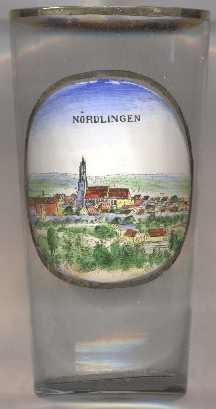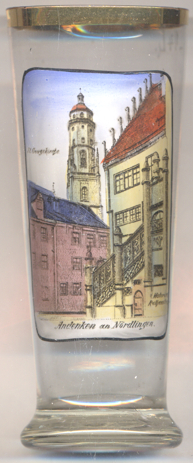

|
| DEUTSCHLAND | GERMANY |
| Bundesland: Freistaat Bayern | Bavaria |
| Regierungsbezirk: Schwaben | |
| Landkreis: Donau-Ries |
 Nördlingen is situated at an elevation of 441 m in the Donau-Ries district of western Bavaria. The municipality has a
population of about 19,700 (2014). Nördlingen lies about 6 km southwest of the centre of the Nördlinger Ries crater,
a meteor impact crater formed about 14.6 million years ago. The Nördlinger Ries is almost circular with a diameter
of 24–26 km; the present floor of the depression is about 100 to 150 m (330 to 490 ft) below the eroded remains of the rim.
Nördlingen is situated at an elevation of 441 m in the Donau-Ries district of western Bavaria. The municipality has a
population of about 19,700 (2014). Nördlingen lies about 6 km southwest of the centre of the Nördlinger Ries crater,
a meteor impact crater formed about 14.6 million years ago. The Nördlinger Ries is almost circular with a diameter
of 24–26 km; the present floor of the depression is about 100 to 150 m (330 to 490 ft) below the eroded remains of the rim.
 The remains of a Roman castellum, built around 85 AD and probably called Septemiacum, have been found under the city.
Remains of Alemannic settlements of the 6th and 7th century followed. The earliest written mention of Nordilinga dates
from 898 AD. During the following periods it developed into a market town under the sovereignty of the bishops of
Regensburg. In 1215 Nördlingen received the privileges of a town from Emperor
Friedrich II and became a Free Imperial City. In 1529, Nördlingen was part of the Protestant minority at the Imperial Diet
of Speyer; in 1555, the Protestant faith was formally confirmed in the city. Following the
Peace of Lunéville (1802) and the Reichsdeputationshauptschluss (Final Recess
of the Imperial Deputation; 1803) Nördlingen lost its status as Free Imperial City and was incorporated into the electorate (1806 kingdom)
of Bavaria.
The remains of a Roman castellum, built around 85 AD and probably called Septemiacum, have been found under the city.
Remains of Alemannic settlements of the 6th and 7th century followed. The earliest written mention of Nordilinga dates
from 898 AD. During the following periods it developed into a market town under the sovereignty of the bishops of
Regensburg. In 1215 Nördlingen received the privileges of a town from Emperor
Friedrich II and became a Free Imperial City. In 1529, Nördlingen was part of the Protestant minority at the Imperial Diet
of Speyer; in 1555, the Protestant faith was formally confirmed in the city. Following the
Peace of Lunéville (1802) and the Reichsdeputationshauptschluss (Final Recess
of the Imperial Deputation; 1803) Nördlingen lost its status as Free Imperial City and was incorporated into the electorate (1806 kingdom)
of Bavaria.
The Lutheran  parish church Sankt Georg [background]
was built in 1427–1505 in late Gothic style. Its characteristic 90 metre high tower was completed in 1490 and is the
landmark of Nördlingen. The tower’s popular name, Daniel, is derived from a verse from the Book of Daniel:
Then the king placed Daniel in a high position and lavished many gifts on him. He made him ruler over the entire
province of Babylon and placed him in charge of all its wise men (
parish church Sankt Georg [background]
was built in 1427–1505 in late Gothic style. Its characteristic 90 metre high tower was completed in 1490 and is the
landmark of Nördlingen. The tower’s popular name, Daniel, is derived from a verse from the Book of Daniel:
Then the king placed Daniel in a high position and lavished many gifts on him. He made him ruler over the entire
province of Babylon and placed him in charge of all its wise men (
The  town hall [foreground right]
was mentioned already in 1313 and was used as town hall since 1382. The upper parts of the building were added around 1500,
the treasury tower followed in in 1509 and the Renaissance stairway in 1618.
town hall [foreground right]
was mentioned already in 1313 and was used as town hall since 1382. The upper parts of the building were added around 1500,
the treasury tower followed in in 1509 and the Renaissance stairway in 1618.
[https://de.wikipedia.org/wiki/Nördlingen, https://en.wikipedia.org/wiki/Nördlingen;
https://en.wikipedia.org/wiki/Nördlinger_Ries]
![[scale]](lineal.jpg)